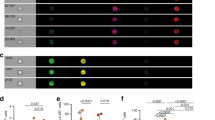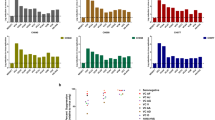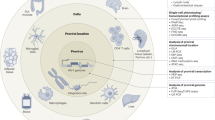Abstract
HIV infection is associated with the progressive loss of CD4+ T cells through their destruction or decreased production1,2. A central, yet unresolved issue of HIV disease is the mechanism for this loss, and in particular whether HIV-specific CD4+ T cells are preferentially affected3,4,5. Here we show that HIV-specific memory CD4+ T cells in infected individuals contain more HIV viral DNA than other memory CD4+ T cells, at all stages of HIV disease. Additionally, following viral rebound during interruption of antiretroviral therapy, the frequency of HIV viral DNA in the HIV-specific pool of memory CD4+ T cells increases to a greater extent than in memory CD4+ T cells of other specificities. These findings show that HIV-specific CD4+ T cells are preferentially infected by HIV in vivo. This provides a potential mechanism to explain the loss of HIV-specific CD4+ T-cell responses, and consequently the loss of immunological control of HIV replication6. Furthermore, the phenomenon of HIV specifically infecting the very cells that respond to it adds a cautionary note to the practice of structured therapy interruption.
This is a preview of subscription content, access via your institution
Access options
Subscribe to this journal
Receive 51 print issues and online access
$199.00 per year
only $3.90 per issue
Buy this article
- Purchase on Springer Link
- Instant access to full article PDF
Prices may be subject to local taxes which are calculated during checkout



Similar content being viewed by others
References
Rowland-Jones, S. HIV infection: where have all the T cells gone? Lancet 354, 5–7 (1999)
McCune, J. M. The dynamics of CD4+ T-cell depletion in HIV disease. Nature 410, 974–979 (2001)
Rosenberg, E. et al. Vigorous HIV-1-specific CD4+ T cell responses associated with control of viremia. Science 278, 1447–1450 (1997)
Rosenberg, E. S. et al. Immune control of HIV-1 after early treatment of acute infection. Nature 407, 523–526 (2000)
Oxenius, A. et al. Early highly active antiretroviral therapy for acute HIV-1 infection preserves immune function of CD8+ and CD4+ T lymphocytes. Proc. Natl Acad. Sci. USA 97, 3382–3387 (2000)
Pitcher, C. J. et al. HIV-1-specific CD4+ T cells are detectable in most individuals with active HIV-1 infection, but decline with prolonged viral suppression. Nature Med. 5, 518–525 (1999)
Betts, M. R. et al. Analysis of total human immunodeficiency virus (HIV)-specific CD4 and CD8 T-cell responses: relationship to viral load in untreated HIV infection. J. Virol. 75, 11983–11991 (2001)
Eckstein, D. A. et al. HIV-1 actively replicates in naive CD4( + ) T cells residing within human lymphoid tissues. Immunity 15, 671–682 (2001)
Altfeld, M. et al. Cellular immune responses and viral diversity in individuals treated during acute and early HIV-1 infection. J. Exp. Med. 193, 169–180 (2001)
Bird, J. J. et al. Helper T cell differentiation is controlled by the cell cycle. Immunity 9, 229–237 (1998)
Kalams, S. A. et al. Association between virus-specific cytotoxic T-lymphocyte and helper responses in human immunodeficiency virus type 1 infection. J. Virol. 73, 6715–6720 (1999)
Wilson, J. D. et al. Loss of CD4+ T cell proliferative ability but not loss of human immunodeficiency virus type 1 specificity equates with progression to disease. J. Infect. Dis. 182, 792–798 (2000)
McNeil, A. C. et al. High-level HIV-1 viremia suppresses viral antigen-specific CD4+ T cell proliferation. Proc. Natl Acad. Sci. USA 98, 13878–13883 (2001)
Pantaleo, G. et al. HIV infection is active and progressive in lymphoid tissue during the clinically latent stage of disease. Nature 362, 355–358 (1993)
Haase, A. T. et al. Quantitative image analysis of HIV-1 infection in lymphoid tissue. Science 274, 985–989 (1996)
Zhang, Z.-Q. et al. Kinetics of CD4+ T cell repopulation of lymphoid tissues after treatment of HIV-1 infection. Proc. Natl Acad. Sci. USA 95, 1154–1159 (1998)
Haase, A. T. Population biology of HIV-1 infection: viral and CD4+ T cell demographics and dynamics in lymphatic tissues. Annu. Rev. Immunol. 17, 625–656 (1999)
Geijtenbeek, T. B. et al. DC-SIGN, a dendritic cell-specific HIV-1-binding protein that enhances trans-infection of T cells. Cell 100, 587–597 (2000)
Cheynier, R. et al. Antigenic stimulation by BCG vaccine as an in vivo driving force for SIV replication and dissemination. Nature Med. 4, 421–427 (1998)
Grossman, Z., Feinberg, M. B. & Paul, W. E. Multiple modes of cellular activation and virus transmission in HIV infection: a role for chronically and latently infected cells in sustaining viral replication. Proc. Natl Acad. Sci. USA 95, 6314–6319 (1998)
Chun, T., Chadwick, K., Margolick, J. & Siliciano, R. Differential susceptibility of naive and memory CD4+ T cells to the cytopathic effects of infection with human immunodeficiency virus type 1 strain LAI. J. Virol. 71, 4436–4444 (1997)
Chun, T. W. et al. Presence of an inducible HIV-1 latent reservoir during highly active antiretroviral therapy. Proc. Natl Acad. Sci. USA 94, 13193–13197 (1997)
Finzi, D. et al. Identification of a reservoir for HIV-1 in patients on highly active antiretroviral therapy. Science 278, 1295–1300 (1997)
Carcelain, G. et al. Transient mobilization of human immunodeficiency virus (HIV)-specific CD4 T-helper cells fails to control virus rebounds during intermittent antiretroviral therapy in chronic HIV type 1 infection. J. Virol. 75, 234–241 (2001)
Blancou, P. et al. The infiltration kinetics of simian immunodeficiency virus-specific T cells drawn to sites of high antigenic stimulation determines local in vivo viral escape. Proc. Natl Acad. Sci. USA 98, 13237–13242 (2001)
Lisziewicz, J. et al. Control of HIV despite the discontinuation of antiretroviral therapy. N. Engl. J. Med. 340, 1683–1684 (1999)
Ortiz, G. M. et al. HIV-1-specific immune responses in subjects who temporarily contain virus replication after discontinuation of highly active antiretroviral therapy. J. Clin. Invest. 104, R13–R18 (1999)
Deeks, S. G. et al. Virologic and immunologic consequences of discontinuing combination antiretroviral-drug therapy in HIV-infected patients with detectable viremia. N. Engl. J. Med. 344, 472–480 (2001)
Altfeld, M. & Walker, B. D. Less is more? STI in acute and chronic HIV-1 infection. Nature Med. 7, 881–884 (2001)
Dybul, M. et al. Short-cycle structured intermittent treatment of chronic HIV infection with highly active antiretroviral therapy: Effects on virologic, immunologic, and toxicity parameters. Proc. Natl Acad. Sci. USA 98, 15161–15166 (2001)
Waldrop, S. L., Pitcher, C. J., Peterson, D. M., Maino, V. C. & Picker, L. J. Determination of antigen-specific memory/effector CD4+ T cell frequencies by flow cytometry: evidence for a novel, antigen-specific homeostatic mechanism in HIV-associated immunodeficiency. J. Clin. Invest. 99, 1739–1750 (1997)
Hanon, E. et al. Fratricide among CD8( + ) T lymphocytes naturally infected with human T cell lymphotropic virus type I. Immunity 13, 657–664 (2000)
Acknowledgements
We thank the patients and staff at UTSW Medical Center and the NIH for their cooperation, and M. Roederer and J. Mascola for their help. This work was supported by the UK Medical Research Council (D.A.P.), the Wellcome Trust, and the National Institutes of Health (S.W.).
Author information
Authors and Affiliations
Corresponding author
Ethics declarations
Competing interests
The authors declare that they have no competing financial interests
Rights and permissions
About this article
Cite this article
Douek, D., Brenchley, J., Betts, M. et al. HIV preferentially infects HIV-specific CD4+ T cells. Nature 417, 95–98 (2002). https://doi.org/10.1038/417095a
Received:
Accepted:
Issue Date:
DOI: https://doi.org/10.1038/417095a
This article is cited by
-
Potential molecular mechanisms of chronic fatigue in long haul COVID and other viral diseases
Infectious Agents and Cancer (2023)
-
CD8+ T cells control SIV infection using both cytolytic effects and non-cytolytic suppression of virus production
Nature Communications (2023)
-
Molecular Mechanisms of HIV-1 Latency from a Chromatin and Epigenetic Perspective
Current Clinical Microbiology Reports (2023)
-
Schlafen 12 restricts HIV-1 latency reversal by a codon-usage dependent post-transcriptional block in CD4+ T cells
Communications Biology (2023)
-
HIV silencing and cell survival signatures in infected T cell reservoirs
Nature (2023)
Comments
By submitting a comment you agree to abide by our Terms and Community Guidelines. If you find something abusive or that does not comply with our terms or guidelines please flag it as inappropriate.



